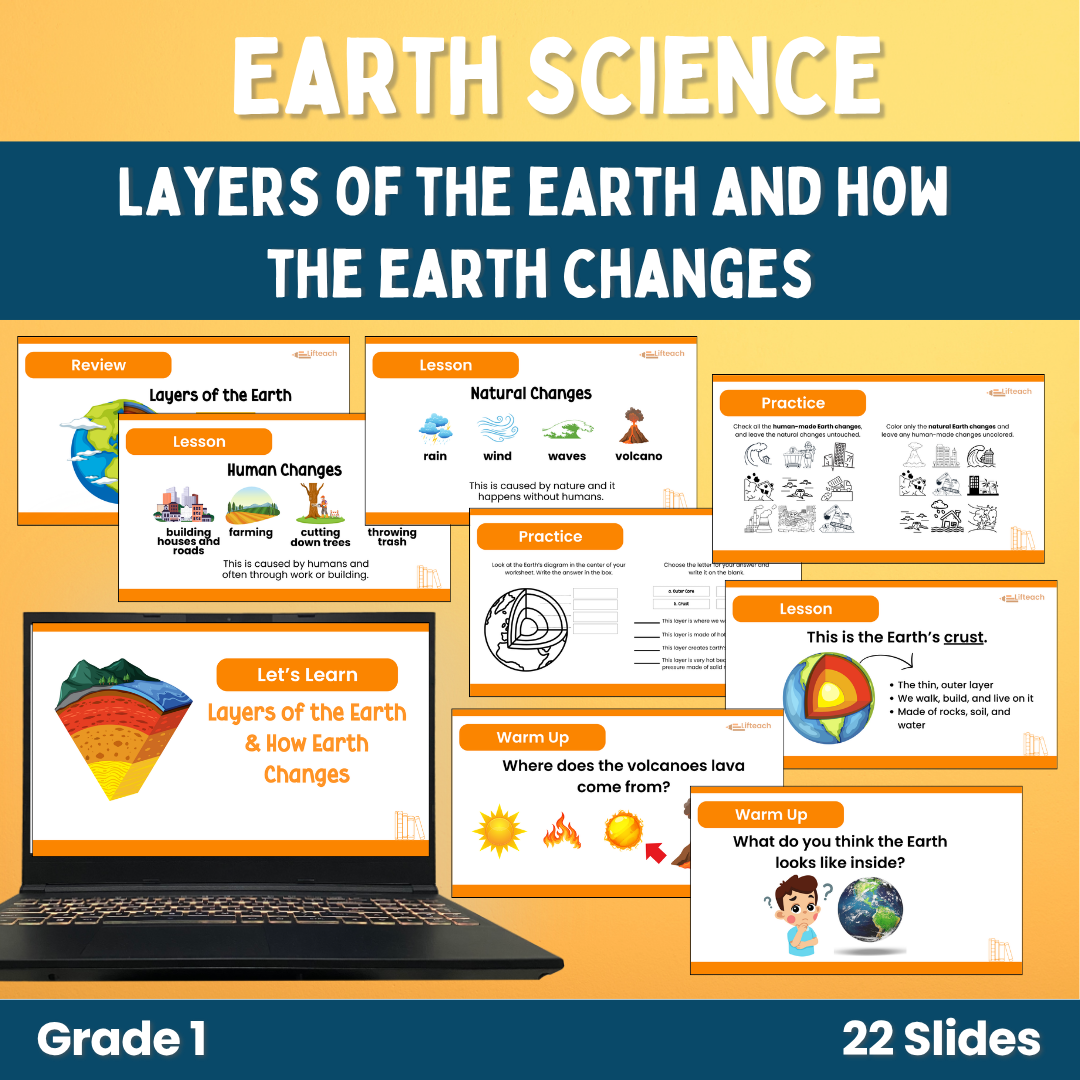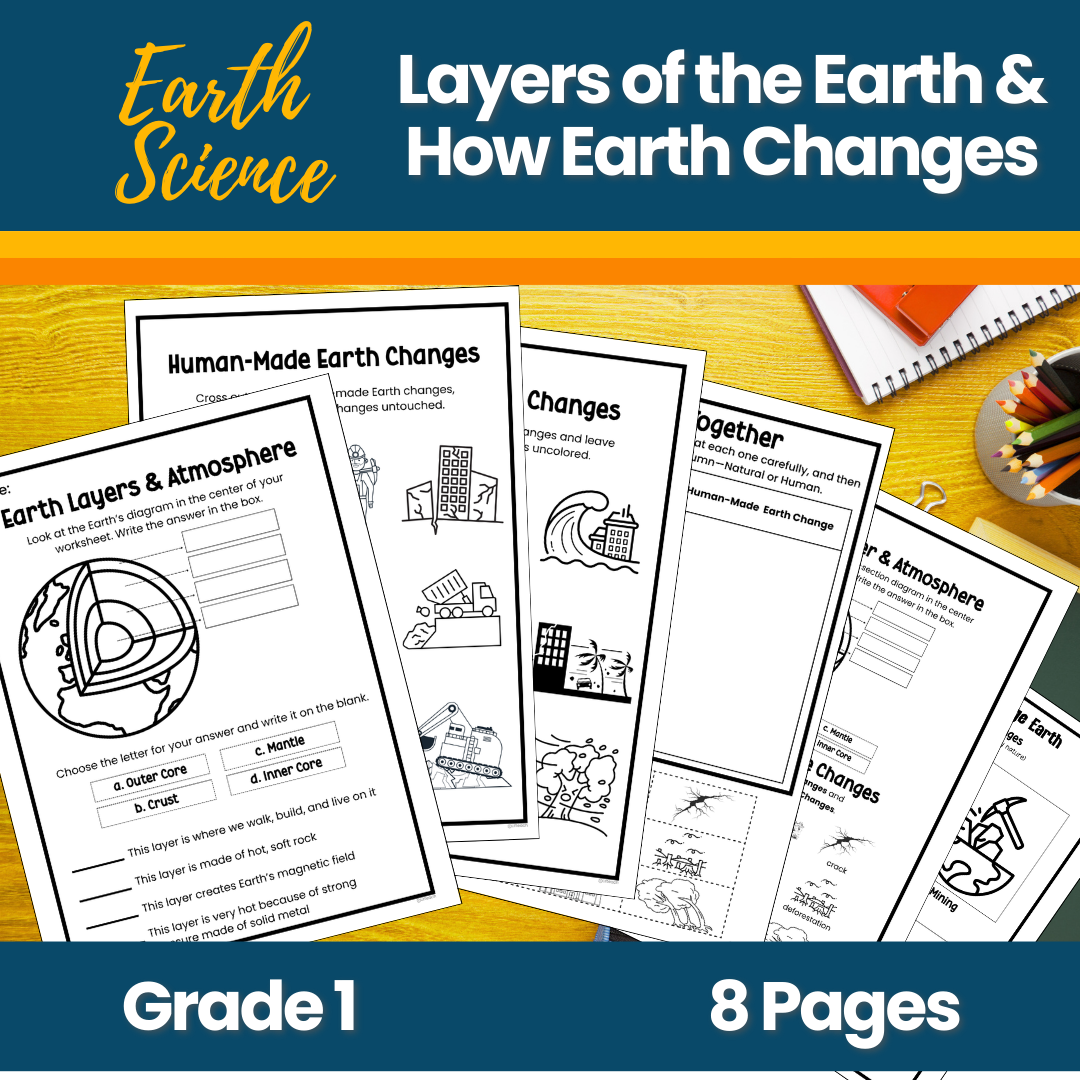Lesson Plan: The Earth’s Atmosphere
Grade Level: Grade 1
Subject: Earth Science
Duration: 50 minutes
1. Learning Objectives
- By the end of this lesson, students will be able to
- Name and describe the three main layers of the Earth (crust, mantle, and core) and the atmosphere.
- Identify one natural process (e.g., rain, wind) and one human process (e.g., building, farming) that change the Earth’s surface or local climate.
- Explain, in simple terms, how these processes shape the Earth and affect weather.
2. Standards Alignment
Next Generation Science Standards (NGSS)
- 1-ESS2-1: Use observations of rocks, soil, and water to describe Earth materials.
- 1-ESS2-2: Explore how wind and water can change the shape of the land.
- 1-ESS3-1: Describe how humans use Earth’s resources.
Common Core State Standards (CCSS)—ELA
- CCSS.ELA-LITERACY.RI.1.3: Describe connections between two individuals, events, ideas, or pieces of information in a text.
- CCSS.ELA-LITERACY.RI.1.7: Use illustrations and details in a text to describe key ideas.
- CCSS.ELA-LITERACY.SL.1.1: Participate in collaborative conversations with peers and adults.
- CCSS.ELA-LITERACY.W.1.2: Write informative/explanatory texts in which they name a topic and supply some facts.
3. Materials & Resources
- Globe or world map poster
- Colored modeling clay (3 colors)
- Large chart paper & markers
- “Earth Layers & Atmosphere” worksheet (labels & cut-and-paste)
- “Process Match-Up” worksheet (pictures of rain, wind, houses, tractors)
- Crayons, scissors, glue sticks
- Short video clip: “Layers of the Earth for Kids” (2–3 min)
- Picture cards: natural vs. human processes
- Anchor chart: “How We Change Earth”
4. Instructional Activities & Teaching Strategies
A. Introduction (10 min)
- Hook: Show the globe. Ask, “What do you think the Earth is made of inside?”
- Video: Play a 2-minute clip on Earth’s layers.
- Think-Pair-Share: Students share one new thing they saw.
B. Earth Layers Exploration (15 min)
- Modeling (5 min): On chart paper, draw three layers and label them crust, mantle, and core; add “air” for atmosphere.
- Hands-On (10 min):
– Students form three-layer “Earth balls” with clay (brown/blue = crust, red/orange = mantle, yellow = core).
– Label each layer on a sticky note.
C. Natural vs. Human Processes (15 min)
- Discussion (5 min.): Use picture cards to sort “natural” vs. “human” processes on the board.
- Worksheet Activity (10 min): “Process Match-Up” worksheet: Students draw a line from each process to its picture and color.
D. Wrap-Up & Writing (8 min)
- Exit Ticket: On a sticky note, students write (or draw) one way the Earth changes naturally and one way humans change it.
- Share: A few volunteers present their sticky notes.
5. Assessment Methods
- Observation during Think-Pair-Share and sorting activity
- Review of clay models (correct layers/colors)
- “Process Match-Up” worksheet for accuracy
- Exit Ticket for individual understanding
6. Differentiation Strategies
- Emergent ELL Learners: Provide picture-supported word cards; allow drawing rather than writing.
- Advanced Learners: Challenge to name additional processes (e.g., volcano, road building).
- Special Education: Pair with a buddy; pre-cut shapes; simplified worksheet with fewer items.
7. Lesson Timeline
|
Time |
Component |
|
0–10 min |
Introduction & Video |
|
10–25 min |
Earth Layers Exploration |
|
25–40 min |
Natural vs. Human Processes Activity |
|
40–48 min |
Exit Ticket & Sharing |
|
48–50 min |
Clean-up & Transition |
Teacher Reflection (Post-Lesson):
- Did students correctly identify Earth’s layers?
- Which processes caused the most confusion?
- How effective were the hands-on clay models?
- Plan any needed reteaching steps for small groups.


